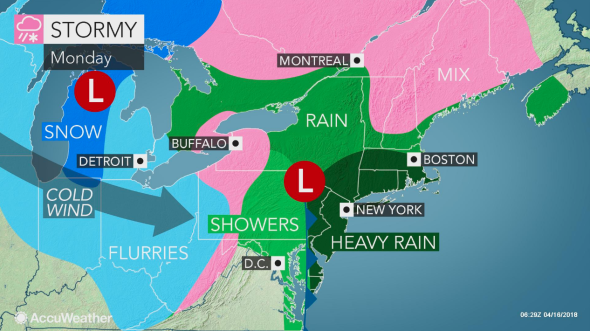Northeastern US to face rare April ice, strong winds, flooding into Monday
The northeastern United States will be faced with a wide variety of adverse weather ranging from a rare April ice storm to strong winds and flooding downpours into Monday.
Areas from upstate New York state to Maine and Massachusetts, as well as the northern Lower Peninsula of Michigan, will be at risk for some accumulation of ice.
Motorists may have to scrape ice or a wintry mix off the windshield and negotiate slippery spots in Plattsburgh, New York; Rutland, Vermont; Concord and Portsmouth, New Hampshire; and Pittsfield and Worcester, Massachusetts.
Rain may even freeze on some elevated surfaces around Albany, New York.
The warming effect of the spring sun tends to minimize the buildup of ice during the daytime. However, subfreezing temperatures and rain at night can still create slippery conditions and weigh down trees and power lines, even in April.
Elevated surfaces, such as bridges and overpasses, will be most prone to a thin accumulation of ice.
Sleet can take more heat away from road surfaces, when compared to light to moderate snow. Where sleet occurs for a time, roads can become slippery at a quick pace, even during the daytime.

The zone of ice will focus on northern New England and eastern Quebec into Monday. Any lingering ice to the south will change to the soaking rain that threatens to trigger flash flooding across the eastern mid-Atlantic and southeast New England on Monday.
Philadelphia, New York City, Hartford and Providence are among the communities at risk for the flooding downpours on Monday.
This rain can pour down heavily at times in Boston, as well, leading to travel delays and creating miserable weather for the Boston Marathon.
As the storm tracks into the Northeast, winds will also increase across the region into Monday.
Winds can gust 40-50 mph in some areas with locally higher gusts.
Such winds can down trees and cause power outages. Branches and wires weakened by the ice or trees sitting in saturated soil will be most prone to being downed.
Coastal flooding may also occur at times of high tide at the Northeast beaches.
At the same time, colder air wrapping around behind the system will allow snow showers to extend southward into the central Appalachians.
